+ Open data
Open data
- Basic information
Basic information
| Entry | Database: PDB / ID: 6rrs | |||||||||
|---|---|---|---|---|---|---|---|---|---|---|
| Title | T=3 MS2 Virus-like particle | |||||||||
 Components Components | Capsid protein | |||||||||
 Keywords Keywords | VIRUS LIKE PARTICLE / MS2 / T=3 / BACTERIOPHAGE / VLP | |||||||||
| Function / homology |  Function and homology information Function and homology informationnegative regulation of viral translation / T=3 icosahedral viral capsid / regulation of translation / structural molecule activity / RNA binding / identical protein binding Similarity search - Function | |||||||||
| Biological species |  Escherichia phage MS2 (virus) Escherichia phage MS2 (virus) | |||||||||
| Method | ELECTRON MICROSCOPY / single particle reconstruction / cryo EM / Resolution: 3.9 Å | |||||||||
 Authors Authors | de Martin Garrido, N. / Ramlaul, K. / Simpson, P.A. / Crone, M.A. / Freemont, P.S. / Aylett, C.H.S. | |||||||||
| Funding support |  United Kingdom, 2items United Kingdom, 2items
| |||||||||
 Citation Citation |  Journal: Mol Microbiol / Year: 2020 Journal: Mol Microbiol / Year: 2020Title: Bacteriophage MS2 displays unreported capsid variability assembling T = 4 and mixed capsids. Authors: Natàlia de Martín Garrido / Michael A Crone / Kailash Ramlaul / Paul A Simpson / Paul S Freemont / Christopher H S Aylett /  Abstract: Bacteriophage MS2 is a positive-sense, single-stranded RNA virus encapsulated in an asymmetric T = 3 pseudo-icosahedral capsid. It infects Escherichia coli through the F-pilus, in which it binds ...Bacteriophage MS2 is a positive-sense, single-stranded RNA virus encapsulated in an asymmetric T = 3 pseudo-icosahedral capsid. It infects Escherichia coli through the F-pilus, in which it binds through a maturation protein incorporated into its capsid. Cryogenic electron microscopy has previously shown that its genome is highly ordered within virions, and that it regulates the assembly process of the capsid. In this study, we have assembled recombinant MS2 capsids with non-genomic RNA containing the capsid incorporation sequence, and investigated the structures formed, revealing that T = 3, T = 4 and mixed capsids between these two triangulation numbers are generated, and resolving structures of T = 3 and T = 4 capsids to 4 Å and 6 Å respectively. We conclude that the basic MS2 capsid can form a mix of T = 3 and T = 4 structures, supporting a role for the ordered genome in favouring the formation of functional T = 3 virions. | |||||||||
| History |
|
- Structure visualization
Structure visualization
| Movie |
 Movie viewer Movie viewer |
|---|---|
| Structure viewer | Molecule:  Molmil Molmil Jmol/JSmol Jmol/JSmol |
- Downloads & links
Downloads & links
- Download
Download
| PDBx/mmCIF format |  6rrs.cif.gz 6rrs.cif.gz | 63.8 KB | Display |  PDBx/mmCIF format PDBx/mmCIF format |
|---|---|---|---|---|
| PDB format |  pdb6rrs.ent.gz pdb6rrs.ent.gz | 38.8 KB | Display |  PDB format PDB format |
| PDBx/mmJSON format |  6rrs.json.gz 6rrs.json.gz | Tree view |  PDBx/mmJSON format PDBx/mmJSON format | |
| Others |  Other downloads Other downloads |
-Validation report
| Summary document |  6rrs_validation.pdf.gz 6rrs_validation.pdf.gz | 1.3 MB | Display |  wwPDB validaton report wwPDB validaton report |
|---|---|---|---|---|
| Full document |  6rrs_full_validation.pdf.gz 6rrs_full_validation.pdf.gz | 1.3 MB | Display | |
| Data in XML |  6rrs_validation.xml.gz 6rrs_validation.xml.gz | 24.3 KB | Display | |
| Data in CIF |  6rrs_validation.cif.gz 6rrs_validation.cif.gz | 33.6 KB | Display | |
| Arichive directory |  https://data.pdbj.org/pub/pdb/validation_reports/rr/6rrs https://data.pdbj.org/pub/pdb/validation_reports/rr/6rrs ftp://data.pdbj.org/pub/pdb/validation_reports/rr/6rrs ftp://data.pdbj.org/pub/pdb/validation_reports/rr/6rrs | HTTPS FTP |
-Related structure data
| Related structure data |  4989MC  4990C  6rrtC M: map data used to model this data C: citing same article ( |
|---|---|
| Similar structure data | |
| EM raw data |  EMPIAR-10706 (Title: Mixed capsids of MS2 virions / Data size: 113.1 EMPIAR-10706 (Title: Mixed capsids of MS2 virions / Data size: 113.1 Data #1: MS2 virion-like particles [micrographs - single frame]) |
- Links
Links
- Assembly
Assembly
| Deposited unit | 
|
|---|---|
| 1 | x 60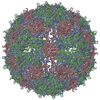
|
- Components
Components
| #1: Protein | Mass: 13869.659 Da / Num. of mol.: 3 Source method: isolated from a genetically manipulated source Source: (gene. exp.)  Escherichia phage MS2 (virus) / Production host: Escherichia phage MS2 (virus) / Production host:  |
|---|
-Experimental details
-Experiment
| Experiment | Method: ELECTRON MICROSCOPY |
|---|---|
| EM experiment | Aggregation state: PARTICLE / 3D reconstruction method: single particle reconstruction |
- Sample preparation
Sample preparation
| Component | Name: Escherichia virus MS2 / Type: VIRUS / Entity ID: all / Source: RECOMBINANT |
|---|---|
| Molecular weight | Experimental value: NO |
| Source (natural) | Organism:  Escherichia virus MS2 Escherichia virus MS2 |
| Source (recombinant) | Organism:  |
| Details of virus | Empty: NO / Enveloped: NO / Isolate: OTHER / Type: VIRUS-LIKE PARTICLE |
| Buffer solution | pH: 7.5 / Details: 10 mM Tris-HCl pH 7.5, 1 mM EDTA, 100 mM NaCl |
| Specimen | Embedding applied: NO / Shadowing applied: NO / Staining applied: NO / Vitrification applied: YES |
| Specimen support | Grid material: COPPER / Grid mesh size: 300 divisions/in. / Grid type: Quantifoil R1.2/1.3 |
| Vitrification | Instrument: FEI VITROBOT MARK IV / Cryogen name: ETHANE / Humidity: 95 % / Chamber temperature: 278 K |
- Electron microscopy imaging
Electron microscopy imaging
| Experimental equipment |  Model: Tecnai F20 / Image courtesy: FEI Company |
|---|---|
| Microscopy | Model: FEI TECNAI F20 |
| Electron gun | Electron source:  FIELD EMISSION GUN / Accelerating voltage: 200 kV / Illumination mode: FLOOD BEAM FIELD EMISSION GUN / Accelerating voltage: 200 kV / Illumination mode: FLOOD BEAM |
| Electron lens | Mode: BRIGHT FIELD / Nominal magnification: 100000 X / Nominal defocus max: -2000 nm / Nominal defocus min: -300 nm / Cs: 2 mm / C2 aperture diameter: 50 µm / Alignment procedure: COMA FREE |
| Specimen holder | Cryogen: NITROGEN Specimen holder model: GATAN 626 SINGLE TILT LIQUID NITROGEN CRYO TRANSFER HOLDER |
| Image recording | Average exposure time: 4 sec. / Electron dose: 80 e/Å2 / Film or detector model: FEI FALCON I (4k x 4k) / Num. of grids imaged: 4 / Num. of real images: 1040 Details: Frames were obtained with a beam-splitter and recorded at 100kx |
| Image scans | Sampling size: 14 µm / Width: 4096 / Height: 4096 |
- Processing
Processing
| EM software |
| ||||||||||||||||||||||||
|---|---|---|---|---|---|---|---|---|---|---|---|---|---|---|---|---|---|---|---|---|---|---|---|---|---|
| Image processing | Details: Dose weighting was applied with MotionCor2 | ||||||||||||||||||||||||
| CTF correction | Details: Internal in RELION / Type: PHASE FLIPPING AND AMPLITUDE CORRECTION | ||||||||||||||||||||||||
| Symmetry | Point symmetry: I (icosahedral) | ||||||||||||||||||||||||
| 3D reconstruction | Resolution: 3.9 Å / Resolution method: FSC 0.143 CUT-OFF / Num. of particles: 899 / Algorithm: FOURIER SPACE Details: Resolution within a tight mask was 3.9 by FSC 0.143 cut-off while unmasked resolution was 5. Num. of class averages: 1 / Symmetry type: POINT | ||||||||||||||||||||||||
| Atomic model building | Protocol: RIGID BODY FIT / Space: REAL / Target criteria: Cross-correlation coefficient / Details: Dimers were fitted independently | ||||||||||||||||||||||||
| Atomic model building | PDB-ID: 5TC1 Accession code: 5TC1 / Source name: PDB / Type: experimental model |
 Movie
Movie Controller
Controller



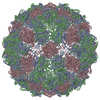
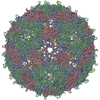
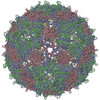
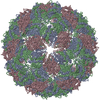
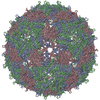
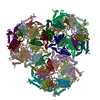
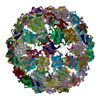
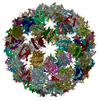
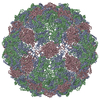
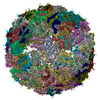

 PDBj
PDBj

